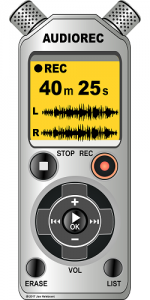Recording Tips
 We have put together a list of recording tips that can help you achieve the best possible results with your recording. The quality of the transcription greatly depends on the quality of the audio received and, by following these tips, you can ensure that your hard work pays off.
We have put together a list of recording tips that can help you achieve the best possible results with your recording. The quality of the transcription greatly depends on the quality of the audio received and, by following these tips, you can ensure that your hard work pays off.
If you haven’t conducted your recording yet, we recommend that you keep these transcription tips in mind to help you create high-quality audio. However, even if you have already completed your recordings, these tips can still help you better understand your transcription.
It is important to note that it’s not possible to correct poor recordings, remove interference, or improve sound quality after the recording has been done. Therefore, it’s crucial to ensure that you follow these recording tips and record the best possible audio right from the start. This will help us produce the most accurate transcription for you.
Audio Quality
When it comes to audio recording, it is highly recommended to use a bit rate of at least 64 kbps to achieve optimal results. The higher the bit rate, the better the clarity of the audio. Although the file size may be larger with a higher bit rate, there will be no trade-off in terms of audio quality. In other words, by increasing the bit rate, you can enhance the audio fidelity without any compromise. Therefore, it is important to prioritise the bit rate when recording audio to ensure the best possible listening experience.
Audio Format
 We strive to accommodate our clients by accepting a wide variety of audio formats. With the widespread use of cell phones for recording, we understand that these recordings often use different formats than traditional recording devices. However, we want to reassure you that we do accept these audio files and thus far have not encountered any issues in finding a suitable conversion program to convert these files to commonly used formats such as WAV or MP3.
We strive to accommodate our clients by accepting a wide variety of audio formats. With the widespread use of cell phones for recording, we understand that these recordings often use different formats than traditional recording devices. However, we want to reassure you that we do accept these audio files and thus far have not encountered any issues in finding a suitable conversion program to convert these files to commonly used formats such as WAV or MP3.
That being said, in the event that you submit an audio file in an unusual format that requires a more specialised conversion process, we may need to charge an additional fee for the conversion. We want to be transparent about our fees and policies, so we encourage you to contact us for more information.
Setup
If you want to ensure high-quality recordings, there are a few steps you should take. First and foremost, find a quiet place in order to minimise background noise. This could be a closed-off room, a soundproof booth, or simply a space with minimal outside distractions.
Once you have your recording space set up, it is important to position your recorder or microphone close to the speakers. This will not only make it easier to capture their voices but also improve the overall clarity of the audio. Additionally, starting the recording a few seconds before the conversation begins can help ensure that no important details are missed.
Another key factor in producing great audio recordings is minimising interruptions and interference. Make sure to switch off any cell phones or electronic devices that could cause distractions or disrupt the recording. This will not only help keep the focus on the conversation but also prevent any unwanted interference from cell phone reception.
By following these simple setup tips, you can improve the quality of your audio recording and ensure that you capture all the important details. Whether you’re recording a business meeting, a lecture, or a personal conversation, taking these steps will help you produce the best possible audio.
Noise Interference/Disturbances
 To ensure high-quality recordings, it is crucial to be mindful of the various noises that can interfere with the audio. Even seemingly insignificant sounds can be magnified by the microphone or recorder, potentially overpowering the speaker’s voice. To illustrate, consider the following examples:
To ensure high-quality recordings, it is crucial to be mindful of the various noises that can interfere with the audio. Even seemingly insignificant sounds can be magnified by the microphone or recorder, potentially overpowering the speaker’s voice. To illustrate, consider the following examples:
Papers Rustling
If someone nearby is shuffling through papers while someone else is speaking, it can be distracting and affect the overall quality of the audio. To avoid this, kindly request the paper-shuffler to relocate away from the recorder/microphone. Additionally, consider moving the recorder/microphone closer to the speaker during this time to capture clear audio. However, be sure to return it to its original position once the paper shuffling has ceased.
Cups and Saucers
Tea breaks are common during long meetings. However, when participants return to the recording area, the stirring or placing of cups on saucers can create distracting background noise that can affect the quality of the recording. However, there are simple solutions to these problems.
encourage participants to stir their beverages before the recording commences and place their cups as far away from the recorder/microphone as possible. Alternatively, using cups without saucers can help reduce noise. Additionally, placing a soft placemat underneath the cup can effectively dampen the sound of cups clinking against saucers or the table.
Coughing, Sneezing, or Throat Clearing
Coughing, sneezing, or clearing the throat can produce loud noises that overpower the speaker’s voice. Even if they do so as quietly as possible, these sounds can still be amplified and interfere with the recording. To prevent this from happening, kindly ask participants to turn away from the recorder/microphone if they feel the need to cough, sneeze, or clear their throat. Additionally, request the speaker to repeat what they said to ensure that it’s clearly captured on the recording.
Traffic Noise
Recording audio in a heavy-traffic area can be challenging due to the presence of external noise. To minimise unwanted noise, it is important to keep all windows closed and position the recorder/microphone as far away from the window as possible. Additionally, it is crucial to be aware of various sounds like vehicles honking, trucks reversing (beep-beep), and other such noises that could interfere with the recording.
In cases of such distractions, ask the speaker to repeat what they said to ensure clarity in the recording. Alternatively, you may need to pause the recording until the noise has subsided.
Cell Phone Interference
Although it is not as common these days, placing a cell phone close to the recorder/microphone can still cause significant interference, impacting the quality of your recordings. Although everything might seem normal while recording, the interference may become evident on playback, making it difficult to hear the content clearly. Even cell phones set to silence mode can create interference if placed near the recording device. Additionally, cell phone vibrations next to the recorder/microphone can disrupt the audio quality. Therefore, it is crucial to switch off cell phones or place them far away from the recorder/microphone, ensuring that your audio recordings are of the highest quality.
Air-Conditioner/Fan
Recording audio in a room with a noisy air-conditioner/fan can be challenging. However, there are a few simple steps that you can take to minimise the impact of these external factors on your recording. First, it is essential to keep the air-conditioner/fan as low as possible to reduce the noise level. Additionally, ask the participants to speak louder than normal and position themselves closer to the recorder/microphone. If possible, sit at the end of the room furthest away from the air-conditioner/fan to reduce the noise level.
Construction Noise
Recording audio in a location where there is construction noise can be extremely challenging. It is essential to take certain measures to ensure the best possible recording quality. Whether the construction noise is inside or outside the building, it is crucial to try to ask for a change of venue, if possible. If this is not possible, the next best solution is to close all windows (outside construction noise) and doors (inside construction noise). Additionally, sitting as far away as possible from these windows or doors can help reduce the noise levels. To ensure that participants’ voices are audible above the construction noise, ask them to speak louder than usual and position themselves closer to the recorder/microphone.
Banging/Tapping on the Table
It is essential to remind attendees to refrain from banging or tapping anything on the table. While it may seem harmless, the recorder/microphone can amplify these noises, making it difficult to discern what was said. If an accidental noise does occur, kindly ask the speaker to repeat their previous statement to ensure that nothing important is lost or misunderstood.
Pen Clicking
It is important to remind attendees to avoid the constant clicking of their pens. While it might seem like a harmless habit, the sound can be amplified by the recorder/microphone, potentially overpowering the speaker’s voice and making it difficult to follow the discussion.
Venue Noise
When choosing a venue, it is important to avoid locations with excessive ambient noise, such as coffee shops, company cafeterias, and outdoor areas. These environments can be unpredictable and may make it difficult to capture clear audio. If these locations are unavoidable, ask the participant to speak directly into the recorder and to speak louder than normal.
Notes on Noise
To ensure a successful recording, it’s important to take a few minutes to assess the environment before anyone arrives. Close your eyes and listen carefully, taking note of any sounds that could potentially disrupt the recording. Whenever possible, take steps to eliminate or reduce these sounds, such as by closing windows or doors to block outside noise.
In addition to addressing external noise sources, it’s important to consider the chairs being used in a room. Test each chair for noise levels and, if possible, switch out any chairs that are particularly noisy. If this isn’t an option, kindly ask the participant who uses the noisy chair to minimise movement during the session to prevent additional noise.
In situations where it’s not possible to reduce background noise, it may be necessary to ask participants to speak louder than normal to ensure that their voices can be clearly heard. Encourage everyone to maintain a consistent volume level throughout the session to prevent inconsistencies in the recording.
Finally, if there are any sudden noises or interruptions during the recording, kindly ask speakers to repeat what they just said before continuing. While it may be frustrating to repeat information, it’s better to have the same thing twice than to miss out on important details. By being proactive and mindful of the environment, you can ensure that your recording is clear.
Speaking During Recording
When it comes to recording audio, the way that speakers talk during the session is crucial. If their words are difficult to hear or understand, it can be easy to miss important details and lose the context of the subject being discussed. This can have a ripple effect throughout the recording, making it difficult to transcribe accurately and potentially leading to errors in the final product.
To ensure you get the best possible recording, and therefore transcription, there are a few things you can ask your speakers to do.
Speak Clearly
It is important to ask your participants to take their time when speaking and to make a conscious effort to articulate each word clearly. If they tend to mumble, kindly ask them to speak more deliberately.
Speak Slowly
It’s important to encourage your speakers to take their time and speak slowly and deliberately. Speakers who talk quickly can often have their words run together, making it difficult to discern individual words and leading to errors in the final transcription. By asking your speakers to slow down and take their time, you can ensure that each word is clearly enunciated and that the resulting transcription is accurate.
In addition to improving clarity, speaking slowly can also help speakers avoid stuttering, stammering, or hesitating as they will have more time to collect their thoughts and form complete sentences. Another benefit of speaking slowly is that it can help improve the overall flow of the conversation, making it easier for listeners to follow along and understand the progression of ideas.
Voice Volume
One of the most important factors in recording high-quality audio is ensuring that your speakers are speaking at an appropriate volume. When speakers speak too quietly, it can be difficult to discern individual words, which can lead to errors in the final transcription.
To help ensure that everyone’s voice is clearly heard, it can be helpful to ask participants with quieter voices to sit closer to the recorder/microphone. This can help ensure that their words are captured clearly and can be transcribed accurately. In addition to proximity to the recording equipment, it is also important to encourage your speakers to speak at a consistent volume throughout the session.
Heavy Accents
Accents can add an extra layer of complexity to transcription, especially if they are particularly strong. While it’s not always possible to avoid or change accents, there are a few things you can do to help ensure that the transcription is as accurate as possible.
First and foremost, it is important to communicate clearly with your speakers about the importance of speaking as clearly and distinctly as possible. Encourage them to take their time and to enunciate carefully.
It can also be helpful to provide us with any additional information or context that might help us better understand the speaker’s accent.
Simultaneous Talking
One thing to keep in mind is the importance of avoiding interruptions and overlapping conversations. When multiple speakers are involved, it can be challenging to ensure that everyone is heard clearly and that there is no confusion or overlap between speakers.
To minimise these issues, it’s important to encourage participants to refrain from talking over one another. Instead, encourage them to allow one speaker to finish talking before another speaker starts talking. This will help ensure that each speaker’s words are clearly captured and that there is no overlap or confusion between speakers.
If you do need to interrupt a speaker for any reason, be sure to do so with a brief indication or signal, such as raising your voice or making a brief sound. Allow the speaker to stop talking before proceeding as this will ensure that their words are captured accurately and without interruption.
Special Notes for Multiple Speakers
 When conducting a recording with a group of people, it is important to take note of several key factors to ensure your final recording is clear and accurately captures the conversation at hand.
When conducting a recording with a group of people, it is important to take note of several key factors to ensure your final recording is clear and accurately captures the conversation at hand.
Simultaneous Talking
One of the biggest challenges can be managing the conversation and ensuring that all participants are able to speak and be heard without interruption. This can be especially difficult when participants are passionate or excited about the topic being discussed.
To address this issue, it’s important to establish clear ground rules for the conversation and communicate these to your participants at the beginning of the recording session. Encourage participants to allow each other to finish speaking before chiming in and to avoid interrupting one another or talking over one another.
In addition, you may want to consider using a recording device that allows you to clearly distinguish between different speakers. This can help you to more easily identify who is speaking at any given moment and can also make it easier to transcribe the recording accurately.
Recorders/Microphones
When recording with large groups, it is important to consider the following factors to ensure the best quality recording:
- Provide each participant with their own microphone to prevent sound overlap and to ensure clear and distinct audio. Alternatively, use more than one recording device.
- If you’re using a recorder, avoid placing it in the centre of the table as it may be challenging to capture the audio from those seated further away. Instead, consider using multiple recordings and place them around the table to ensure that everyone’s voice is recorded clearly.
- If you only have one recorder/microphone, make sure to pass it to the participant who is speaking and ask others to avoid speaking until they have the recorder/microphone in their hands.
Speaker Identification
To ensure clear identification of speakers in your recording, it’s important to ask them to identify themselves prior to speaking. If the voices are distinguishable, this only needs to be done once. However, if the voices are similar, speakers should identify themselves each time they speak. Alternatively, consider video recording the session to capture all speakers and use it as an identification tool. Video recordings can be converted to audio for transcription. You could also have a note-taker present to take notes on each speaker and a few keywords to facilitate easy identification.
To make identification even easier, assign each speaker a code to use throughout the session. Have them introduce themselves using this code before the session begins (record the introduction) and then use it when they speak. This way, we can easily pick up their voices and style of talking early on.
It’s important to note that a person’s voice can change, depending on their emotions and excitement levels. A speaker may have a deep, slow voice that may change in pitch, tone, and speed as they get excited.
Clear identification of speakers requires less voice comparison, which can reduce transcription costs and improve turnaround time.
Information Supply
Providing us with as much information as possible can significantly improve the accuracy and quality of the transcription process we provide. This includes details such as the names of all attendees, the meeting agenda or conference programme, interview questionnaires, and any other relevant information.
Rest assured that any information provided to us will be kept strictly confidential and used solely for reference purposes. By having access to this additional information, we can ensure that we capture all relevant content and context, resulting in a more comprehensive and accurate transcription.

